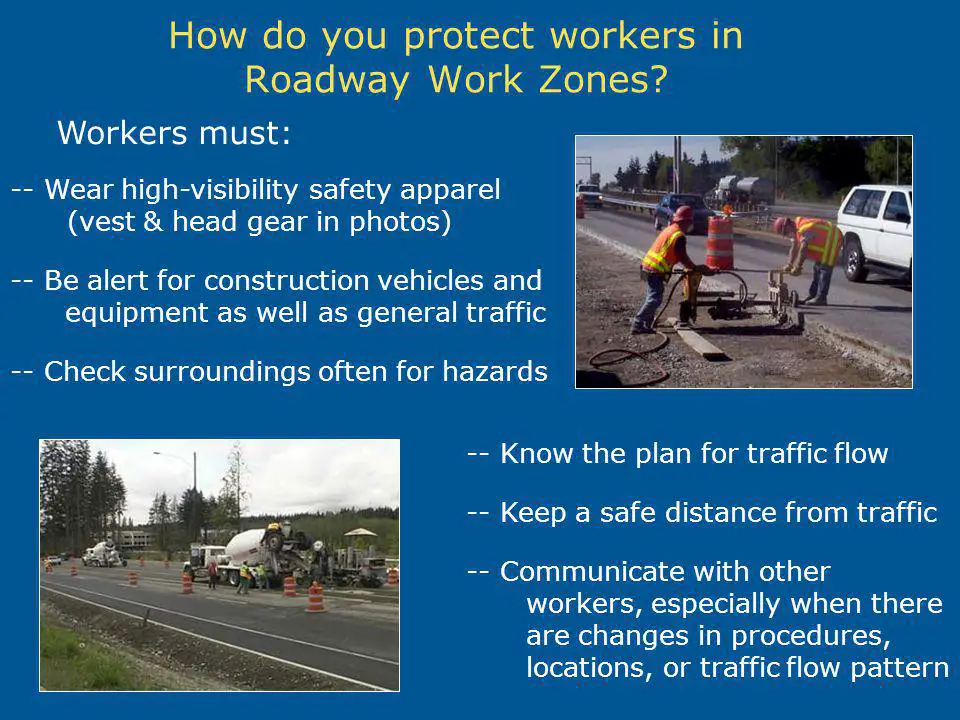Safety Tips For Road Construction Workers

Safety is of utmost importance in the road construction industry. Roads are in constant need of repair and reconstruction, and any defects can cause serious accidents. Road construction work should be undertaken quickly and carefully, to prevent any accidents. Listed below are some helpful tips to keep road construction workers safe.
Work zone inspections
Work zones for road construction are critical to prevent accidents and ensure the safety of construction workers. These zones are defined by the unique characteristics of the site and the varying hazards that exist there. The safety programs for these work zones need to be customized to each site’s characteristics and include individual factors that contribute to the risk of injury for each worker.
Work zone inspections should be conducted on a daily basis. This involves making sure that temporary traffic control devices are properly placed and functioning. Without them, motorists may enter the work zone in the wrong direction. They should also perform daily inspections of construction equipment. If there is an issue with equipment, it should be repaired as soon as possible.
In addition to road construction workers, other roadworkers, such as utility workers, must comply with the state’s work zone standards and regulations. These requirements vary by state. A competent person is responsible for approving traffic control devices and selecting appropriate PPE for workers. In addition, workers should report any unsafe equipment or hazards that they encounter.
Daily inspections
Daily inspections of road construction workers are important to ensure a safe and productive work environment. These checks are done to assess the number of employees on a construction site, how many construction operations are occurring at any given time, and the quality of work being performed. Additionally, these inspections look for any unusual events or conditions on the construction site, as well as damage to government property. The inspectors also check the health and safety of construction workers. They make sure that personal protective equipment is used, including helmets, goggles, and other garments. They also inspect the condition of construction equipment and vehicles to ensure that they are operating safely.
Daily inspections of road construction workers should include a comprehensive review of the safety equipment used on the job, including personal protective equipment, first aid supplies, and emergency protocols. These inspections should also be part of a routine morning meeting to ensure that all employees are on the same page regarding safety. It’s also important to ensure that workers are drinking plenty of water and staying out of direct sunlight, which can cause dehydration and sunstroke, as well as heat exhaustion.
Training
Road construction workers need to pay special attention to safety guidelines and procedures. If they follow these guidelines, they can reduce the number of accidents. A competent person should supervise the workers, identifying hazards and making necessary changes. This person should be aware of the surroundings and should ensure that workers are drinking enough water.
Workers should observe the posted signs that warn them of a work zone. Drivers should also pay attention to any unexpected stops or slowdowns near the work zone. Drivers should also keep their headlights on to alert the crew of their presence. Moreover, they should be aware of any sudden lane changes. This way, they will be better able to navigate the modified road areas.
Workers should also wear highly visible clothing such as fluorescent vests and reflective items. This way, they will be easily spotted and will remain safer even in low-light conditions. Safety meetings should be held weekly to keep the team informed about road construction hazards.
Drinking plenty of water
One of the most important safety tips for road construction workers is to drink plenty of water throughout the day. This is especially important for workers who work in work zones where oncoming traffic can cause a large accident. Another tip for road construction workers is to identify potential hazards in the work zone before beginning. This may include oncoming traffic, power lines, or pedestrian walkways. Identifying potential dangers can also help workers stay alert and avoid accidents. Also, workers should familiarize themselves with construction equipment and how to use them.
Injuries caused by road construction often involve slips and falls. According to the U.S. Department of Transportation, about 20 percent of road construction accidents result from slips and falls. Slips can also occur when workers are working on wet or muddy surfaces. Another way to avoid falls is to fill in any hidden holes or puddles in the pavement.
In hot, humid conditions, road construction workers face the risk of dehydration. As a result, construction companies should supply ample amounts of water to workers and support them in drinking it. The water should be cold and free of any odor.
Be alert
It’s important for drivers to be alert for road construction workers as they enter and exit the work zone. They need to follow the signs posted on the road and be on the lookout for unexpected slow downs or stops near a worksite. Always drive with your headlights on, which will alert construction crews of your presence. The headlights will also help you safely navigate a road that’s been changed for work purposes.
Drivers should avoid work zones if possible. They can be dangerous for both workers and motorists. According to the Bureau of Labor Statistics, approximately one work zone crash causes at least one fatality each year. This is a common occurrence, and motorists should be aware of road construction workers as much as possible.
Drivers should also watch for flaggers and other signs that warn drivers of construction workers. Road workers should wear safety vests that emit short-range radio signals that alert drivers to impending collisions. Using this system can help drivers avoid road accidents and minimize inconveniences, and it can reduce culpability for accidents and injuries.
Beware of heavy equipment
Heavy equipment operators must be extremely cautious to ensure the safety of workers. They should always check overhead power lines and make sure they are de-energized before operating heavy equipment. They should also make sure that the operator of the heavy equipment can clearly see all of the area in which he or she is working. Operators must also be aware of the equipment’s swing radius and avoid working parallel to slopes.
Heavy equipment can be dangerous, so be sure to signal the operator before approaching it. If the operator doesn’t answer, it’s a good idea to move on. Otherwise, you might be hit by falling debris. Make sure you’re aware of the proper signals and how to use them. If you’re not sure what each signal means, consult your supervisor. Make sure that everyone on the crew knows what each signal means.
Heavy equipment can cause injury by ejecting objects from its operation. These items also create noise and other hazards. If a worker is working close to these items, they may be struck or impaled by the moving machinery. If a worker is struck by a large piece of equipment, they can be seriously injured.
Beware of pedestrians
When working on roads, be aware of pedestrians and follow the speed limit. Be especially cautious when you’re working near a school zone. There’s always the possibility of a pedestrian crossing, and drivers need to slow down and anticipate foot traffic. If you’re not sure if pedestrians are on the road, watch for signs warning of road work or law enforcement vehicles.
Pedestrians and drivers should always be cautious around alleys and driveways. When you’re backing out, your vision is limited. If you aren’t paying attention, you may end up hitting a pedestrian or being struck. You should also be extra careful in school zones and residential neighborhoods. If possible, stop at the curb before crossing. You should also be particularly careful at night when roads are slippery.
While drivers must obey traffic signals and come to a complete stop, pedestrians should be especially cautious, particularly when they’re out playing in the street or older. When working on roads, DOT engineers will perform an analysis of intersections and consider accident statistics and pedestrian traffic volumes when designing road improvements.
Beware of speeding traffic
When driving through a road construction zone, drivers should slow down and follow traffic signals and signs. They should continuously scan their mirrors for vehicles trying to overtake and note if a vehicle is entering their blind spots. They should also be hyperalert for construction vehicles and trucks that are pulling into traffic lanes.
Workers in these construction zones are working to improve road conditions and must give enough space to avoid collisions. Typically, four seconds is plenty. However, it is best to double that. You must also remember that construction workers are there to slow down traffic, and ignoring their directions increases your risk of collision and creating a traffic bottleneck.
During construction, motorists should slow down or stop to give workers ample time to stop. Drivers should also obey signs and follow traffic patterns if they are unclear. Drivers should also keep their headlights on at all times so that crew members can see them.




